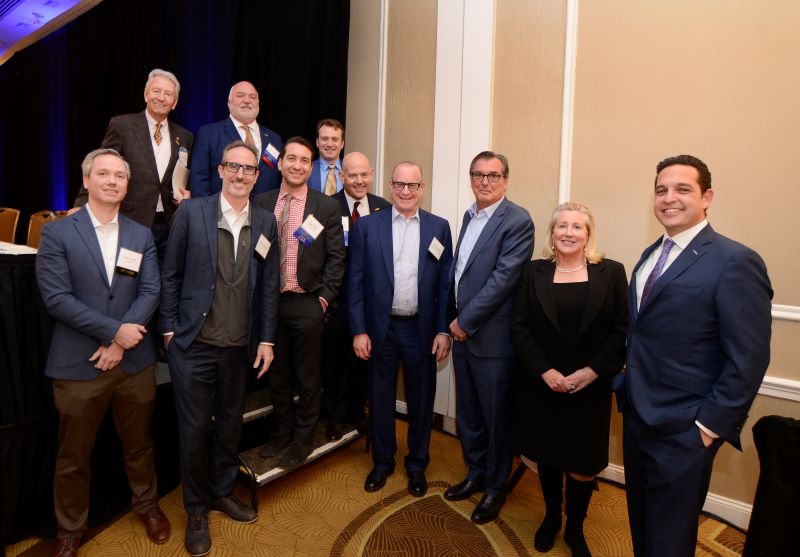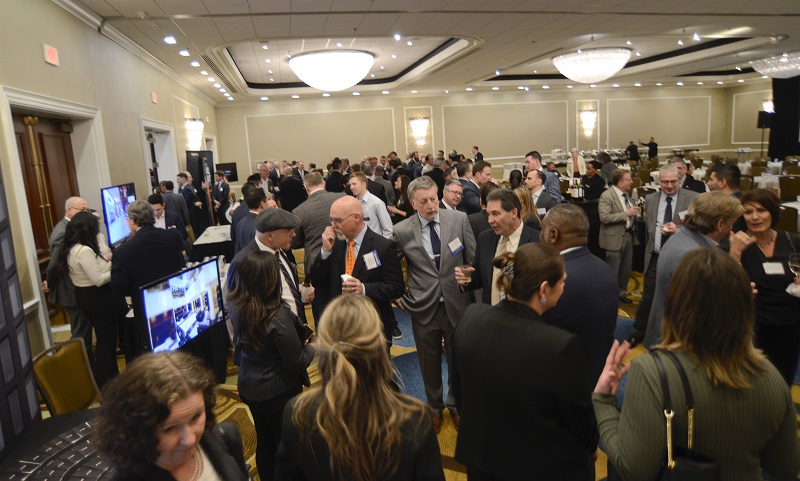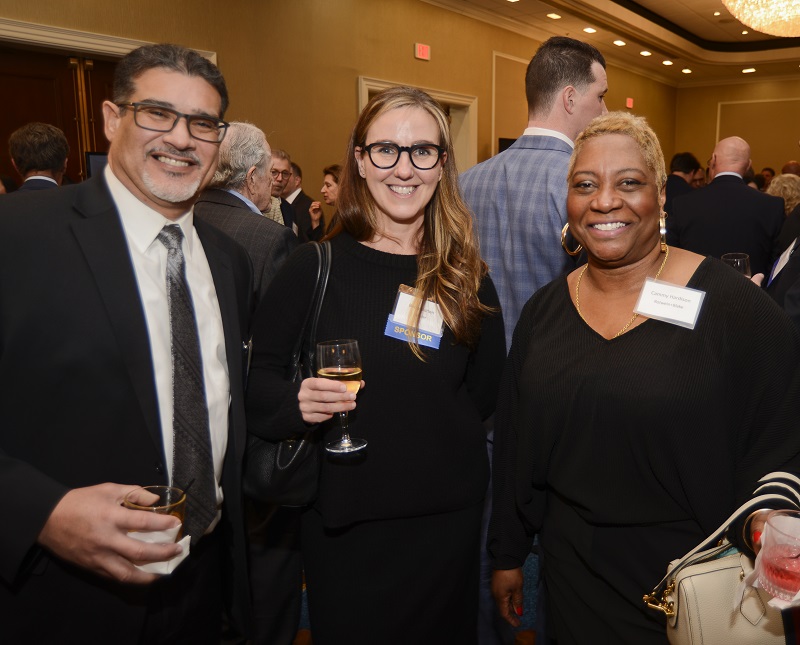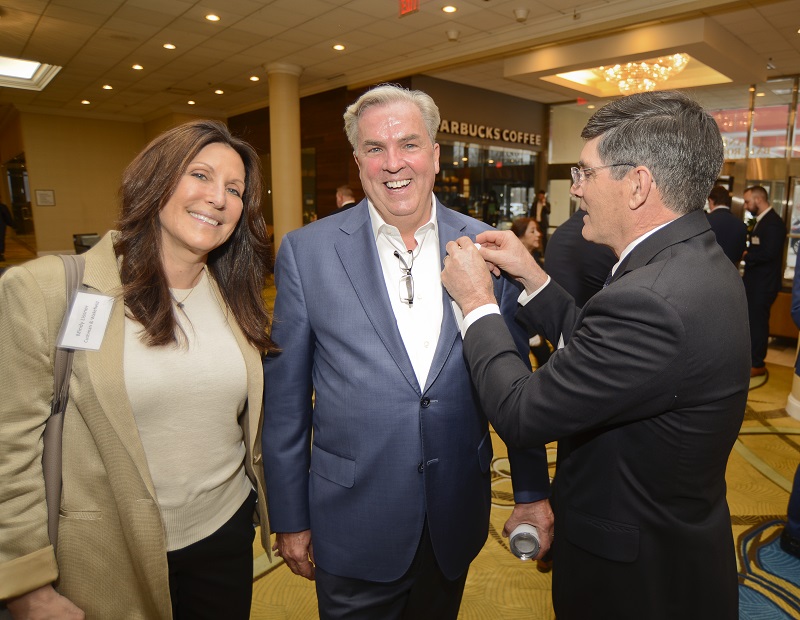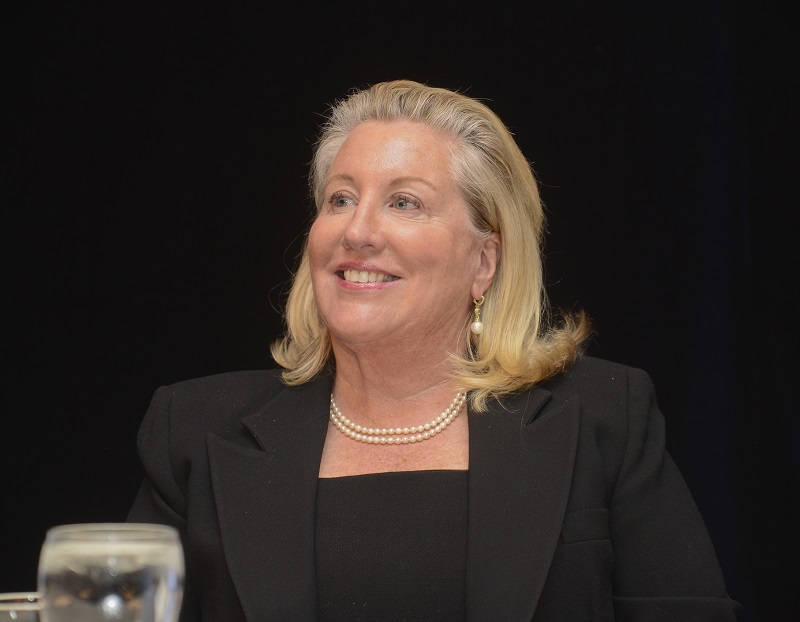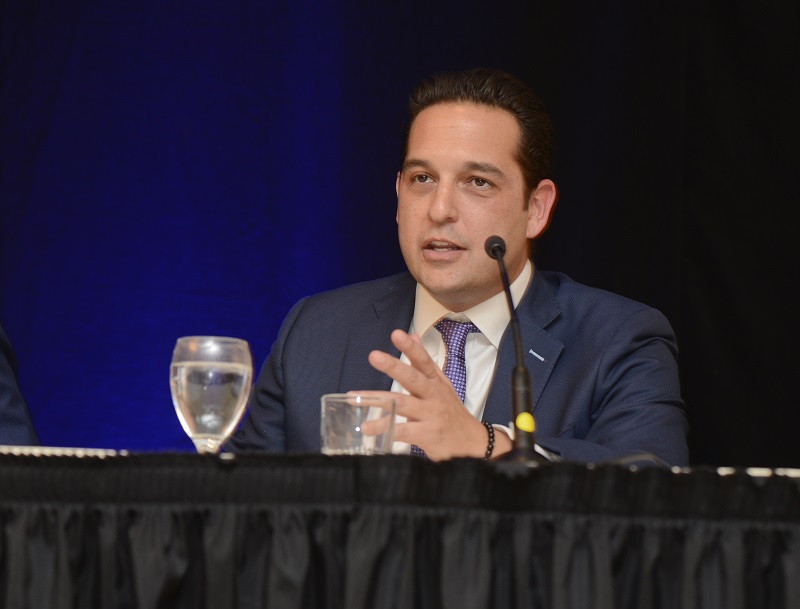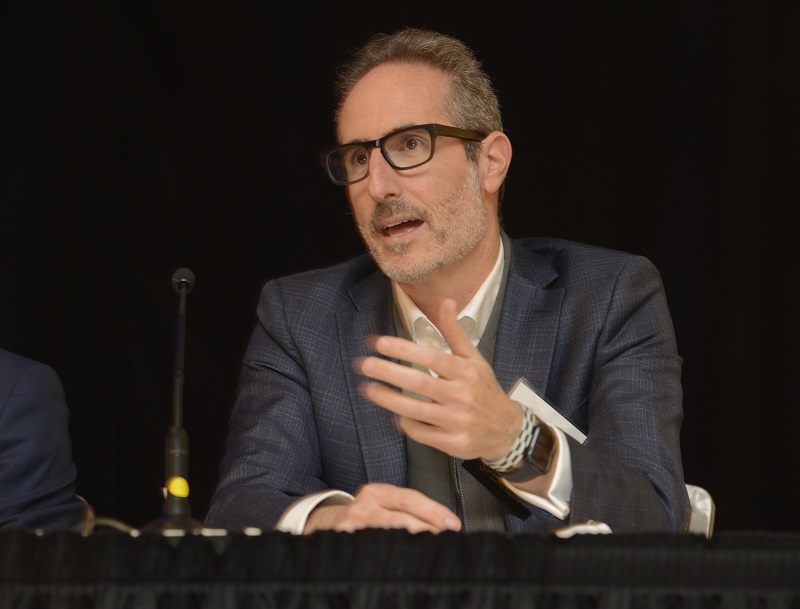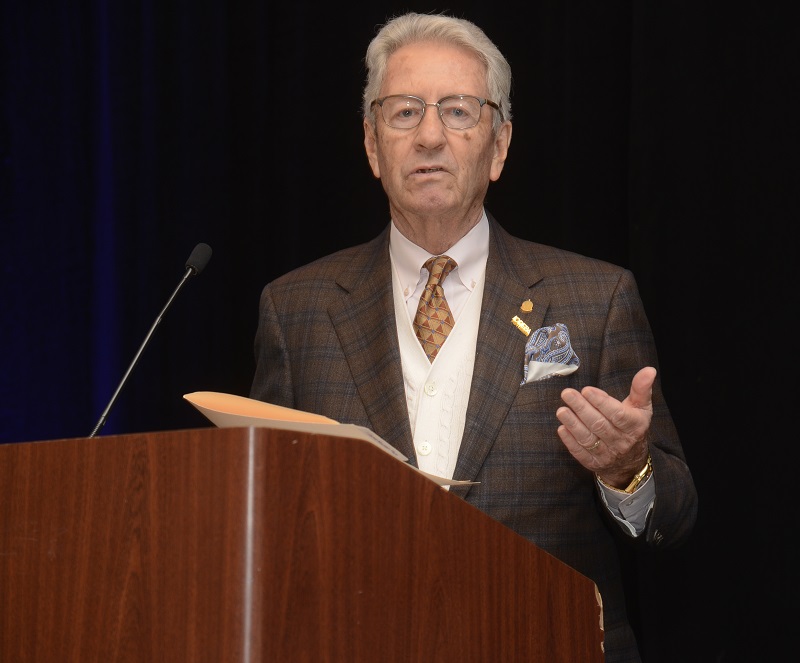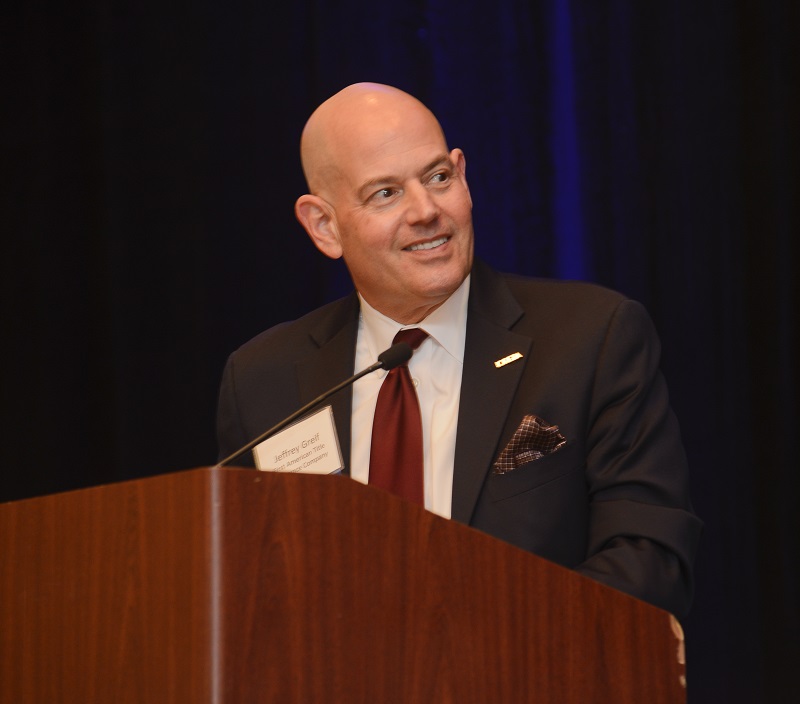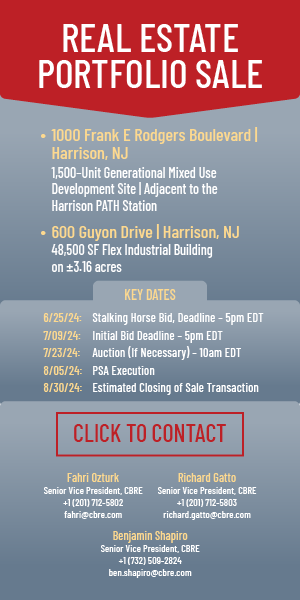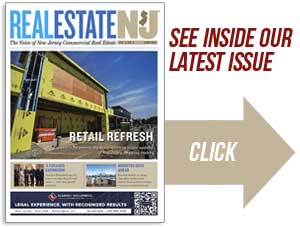Hundreds turned out March 27 for Developers Night, the annual event hosted by the Industrial and Office Real Estate Brokers Association at the Teaneck Marriott at Glenpointe, where a panel of leading industry executives discussed the state of New Jersey commercial real estate. (IOREBA secretary) and Lorenzo Lambiase (IOREBA treasurer). Bottom row, from left: Jesse Harty of Prologis, Jeremy Neuer of JLL, Ryan Tiger of Punia Co. (IOREBA vice president), Jeffrey Greif of First American Title Insurance Co. (IOREBA president), Bill Waxman of Cushman & Wakefield, Rick Vanderbeck of Hartz Mountain Industries, Gretchen Wilcox of G.S. Wilcox & Co. and Peter Bronsnick of Cushman & Wakefield. All photos courtesy: IOREBA
(Editor’s note: This story was updated Monday, April 3, with photos from IOREBA’s Developers Night.)
By Joshua Burd
In a panel discussion filled with candor, insight and humor, Bill Waxman managed to check every box in a single comment on the state of the industrial real estate market.
“I can’t predict the future. I can tell you that we are busy, but I like to compare it to eating soup with a fork,” Waxman, a broker and vice chairman with Cushman & Wakefield, said Monday night, drawing a roar of laughter from the crowd at the Teaneck Marriott at Glenpointe.
“Nobody wants to be the last tenant to pay 25 bucks a foot, so things are taking a lot longer to get done,” he added. “Tenants have choices. Negotiation is back.”
It was a moment that captured a key theme at Developers Night, the annual program hosted by the Industrial and Office Real Estate Brokers Association, where a panel of industry leaders offered both optimism and assuredness, but also frustration about a commercial real estate market that is still fundamentally strong in many respects but grinding along in the face of economic headwinds. That has meant adjusting as demand normalizes after historic highs in asset classes such as industrial and multifamily. In other segments, it has meant grappling with longtime challenges that have been magnified by recent years, such as the state’s glut of older, obsolete office space.
SLIDESHOW: IOREBA Developers Night
The panelists spoke to a registered crowd that was estimated to be around 300, covering everything from unrest in the banking sector and capital markets to the changing industrial sector and the ongoing impact of hybrid work. Below are highlights and takeaways from the discussion, which was moderated by Geoff Schubert of Lee & Associates of New Jersey, edited for space and clarity.
Lending
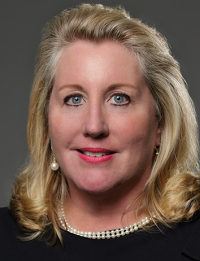
“Certainly, there’s a lot of turmoil out there, especially with the recent bank failures,” said Gretchen Wilcox, founder and president of G.S. Wilcox & Co., the Morristown-based mortgage banking firm. “I think that those are somewhat isolated — there may be few more, but I really don’t see an avalanche kind of effect.
“It has certainly impacted other banks that are lending. We are seeing a lot of banks sort of pulling back, only dealing with existing clients, reducing their loan-to-values, requiring more equity.”
On a more positive note, she added: “We’re seeing an influx from the insurance companies who are coming out with new programs to finance either straight construction loans or fixed-rate construction-to-perm loans, which is very welcome in the market.”
Investment sales
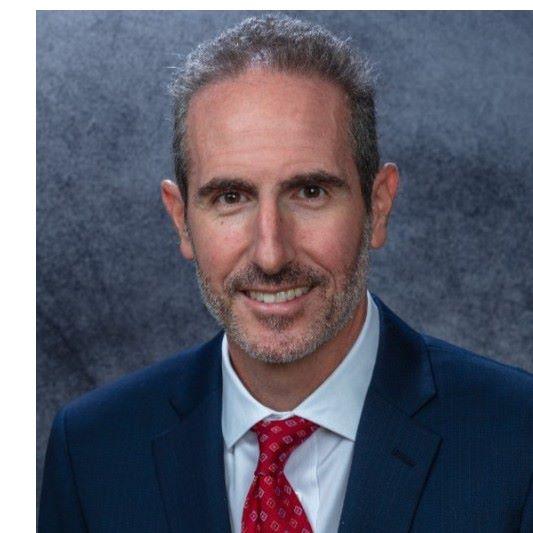
“The second half of the year is going be a lot more transactional than the first half of the year,” said Jeremy Neuer, a senior managing director with JLL’s New Jersey-based capital markets team. “We’ll see what the Fed does on May 3rd … If we get some stability, the lenders will come back. As Gretchen said, the life companies are being very active right now, the banks are obviously a little bit skittish. We need some stabilization in the market.”
In the meantime, he said, JLL has advised many clients and prospective sellers to be patient. On the flip side, now may be the time for well-heeled buyers to strike.
“The better sponsors, the better buyers will find the best opportunities — and there’s going to be a lot of opportunities, as there’s a reset in the market, as there’s a reset in value — to make money.”
Industrial leasing

“I think we’re all trying to figure out how the environment is going to change even further, but we’re very positive,” said Jesse Harty, a senior vice president with Prologis and its market officer in New Jersey and New York. “Luckily … there’s a ton of tractor trailers on the road. People still need to move those goods, so we’re continuing to push rental rates. I would say that second-generation space, existing product, is actually seeing higher rent increases than first-generation, new construction product.”
Regardless, he said, “every new rent is setting a new benchmark.”
Hartz Mountain Industries’ Rick Vanderbeck was similarly bullish, but also pragmatic. For all the political, banking and economic turmoil, occupancy in the Secaucus-based firm’s portfolio is still in the high 90 percent range, he said, while “we’re still trying to get $20 rents in the Meadowlands.

“So, despite the different paths we’re all going down, we remain optimistic and we still think the rates will hold,” said Vanderbeck, a vice president of sales and leasing with Hartz. “Although, at some point, there has to be some kind of correction. I really don’t know how $20 or $25 rents will be sustainable going forward … And I think there’s going be a correction towards the middle.”
Growth of industrial sublease space

“We are definitely seeing more and more shadow space and sublease space coming to the market as a result of multiple things,” Waxman said. “The bottom line is tenants have choices now. So … in my mind it’s a race to equilibrium and I believe that there will be more consolidations, bankruptcies … and that will create more and more opportunities for subleases.”
At the end of the day, he added, vacancy rates are still near historic lows in a region that has more than 800 million square feet of industrial space.
“Yes, there are some opportunities for tenants,” Waxman said. “No, I have not seen a discount in the sublease rate. So the deals that we’re doing that are subleases are not getting a ding because it’s a sublease. The rental rates are holding, and sublandlords are basically doing what institutional landlords are doing, which is holding rents, but playing the net-effective game where you can have some more free rent or (tenant improvements). So I think that trend continues into the next few quarters.”
Remote work

“I actually think that the work-from-home dynamic is beyond a real estate issue — I think it’s a social issue,” said Peter Bronsnick, an executive managing director and New Jersey managing principal with Cushman & Wakefield. That impacts everything from large institutions to local retailers and small businesses, he said, “and we can’t in good conscience ignore its impact on the GDP.”
“I think that we’re all saying the same thing, which is that it’s more convenient for me to work from home. And I think that is a fundamental mistake. You’re going to see it continue to affect our urban centers. … (and) when you start to address an issue is the moment you start to fix an issue. So I am a believer that there is a reason why the better communities, the better towns with the better access to labor are thriving. In the Morristowns of the world, the Summits of the world, the Bridgewaters of the world, along the (Interstate 78) corridor, you’re seeing large deals.
“Granted, (there is) consolidation, contraction, dispositions of corporate campuses throughout the state, but (they’re) identifying better places to be.”
Ultimately, Bronsnick said, “we have to find a way to utilize these environments in a productive manner.
What’s more, “I don’t believe in my heart of hearts that, for the next 35 years, you’re going to see everyone work from their houses. You can be equally as productive, but there is no way you are equally as innovative. And we can’t correct that unless we’re with each other.”

